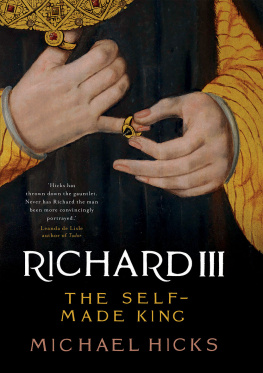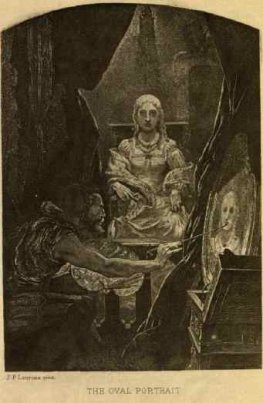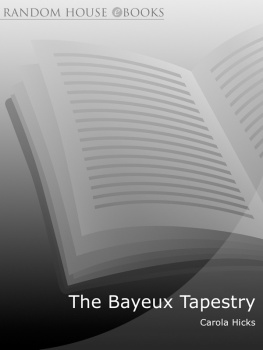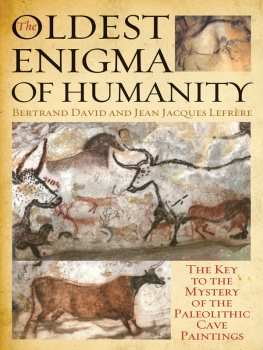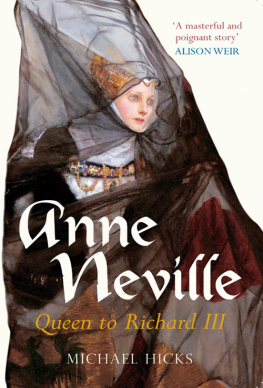Contents
About the Book
The Arnolfini portrait, painted by Jan van Eyck in 1434, is one of the worlds most famous paintings. It intrigues all who see it. Scholars and the public alike have puzzled over the meaning of this haunting gem of medieval art, a subtle and beautiful double portrait of a wealthy Bruges merchant and his wife.
The enigmatic couple seem to be conveying a message to us across the centuries, but what? Is the painting the celebration of marriage or pregnancy, a memorial to a wife who died in childbirth, a fashion statement or a status symbol? Using her acclaimed forensic skills as an art historian, Carola Hicks set out to decode the mystery, uncovering a few surprises along the way.
She also tells the fascinating story of the paintings survival through fires, battles, hazardous sea journeys, and its role as a mirror reflecting the culture and history of the time from jewel of the Hapsburg empire to Napoleonic war trophy. Uniquely, for a masterpiece this old, it can be tracked through every single owner, from the mysterious Mr Arnolfini via various monarchs to a hard-up Waterloo war hero, until it finally came to rest in 1842 as an early star of the National Gallery. These owners, too, have cameo parts in this enthralling story of how an artwork of genius can speak afresh to each new generation.
About the Author
Carola Hicks, an acclaimed art historian, and witty, perceptive writer, died in 2010 just as she was finishing this book. Born in Sussex, Carola studied archaeology at Edinburgh University, and was an actress, journalist and House of Commons Researcher, before taking up an academic career. For several years she was curator of the Stained Glass Museum at Ely Cathedral, and then became a Fellow and Director of Studies in art history at Newnham College, Cambridge. Her books include Animals in Early Medieval Art, Improper Pursuits: The Scandalous Life of Lady Di Beauclerk, and two fine biographies of works of art: The Bayeux Tapestry: The Life Story of a Masterpiece and The Kings Glass: A Story of Tudor Power and Secret Art.
ALSO BY CAROLA HICKS
Animals in Early Medieval Art
Discovering Stained Glass
Improper Pursuits: The Scandalous Life of Lady Di Beauclerk
The Bayeux Tapestry: The Life Story of a Masterpiece
The Kings Glass: A Story of Tudor Power and Secret Art
List of Illustrations
Picture Section
- (National Gallery/ Bridgeman Art Library)
- (National Gallery/ Bridgeman)
- (Groeningemuseum, Bruges/ Bridgeman)
- (St Bavos Cathedral, Ghent, Belgium/ Paul Maeyaert/Bridgeman)
- (Groeningemuseum, Bruges/ Bridgeman)
- (Muse des Arts Royaux, Brussels/ Scala)
- (National Gallery/ Bridgeman)
- (National Gallery/ Bridgeman)
- (Louvre, Paris/ Giraudon/Bridgeman)
- (Private collection/Photo Bonhams, London / Bridgeman)
- ( Tate, London, 2011)
- (Private collection/ Mallett Gallery, London/ Bridgeman)
- ( Tate, London, 2011)
- ( National Portrait Gallery, London)
- (Walker Books)
Illustrations in the text
- (Muse Communal, Bruges/ Bridgeman )
- (National Gallery/ Bridgeman)
- (Washington National Gallery of Art)
- (Bristol City Museum and Art Gallery/ Bridgeman)
- (Society of Antiquaries, London)
- (private collection/ Photo Philip Mould Ltd, London/ Bridgeman)
- (Apsley House, The Wellington Museum, London/ Bridgeman)
- ( National Portrait Gallery, London)
- (Tokyo Fuji Art Museum, Tokyo/ Bridgeman)
- (Kupferstich-kabinett, Dresden/ Staatliche Kunstsammlungen Dresden/ Bridgeman)
- (Habitat plc./History of Advertising Trust, Norwich).
GIRL IN A GREEN GOWN
The History and Mystery of the
Arnolfini Portrait
CAROLA HICKS
The subject of this picture has not been clearly ascertained.
Trustees of the National Gallery, 1843
The finest picture in the world.
Edward Burne-Jones, 1897
This picture seems too alien to grasp, and at the same time entirely straightforward.
Art historian Margaret Kostner, 2003
Foreword
Grayson Perry
My wife was married in green. In a larky wedding snap we pose hand in hand in front of our fireplace, on the mantelpiece a vase I made to celebrate our union. My right hand is raised as if in blessing, her left rests on her pregnant belly. What inspired our nuptial jape was of course a painting over 550 years old. I cannot remember the first time I saw a reproduction of the Arnolfini portrait it must have been in a school art book but it seems to have been in my mind forever. It is a civil ikon, the near symmetry of the composition, full-length depiction of the couple, the neat arrangement of significant objects are reminiscent of the much-kissed artworks of orthodox Christianity. To my modern eyes this painting is an early altar to human love. It is an archetype echoed through art history, by Gainsboroughs Mr and Mrs Andrews and Hockneys Mr and Mrs Clark and Percy, and by those aspirational spreads in Hello! Magazine where we see the accoutrements of social climbing laid out as plainly as in that coolly lit room in Bruges in 1434.
I wonder if it is possible for a relationship with a painting to be akin to that with a marriage partner? The initial glimpse across a crowded room, the first meeting eye to eye, a delightful first date: my gaze roving over the surface, hungry for new joys. Then the marriage: a painting becomes my official favourite. I am often asked what sort of art I like and have a ready list to trot out. But I worry what if I were to read a book solely about one painting, what if I were to know of its long string of past relationships in messy detail? What if I were to be led chapter by chapter through every line, every image, every symbol on its lovely surface would I tire of it? Would over-familiarity bring on the Mona Lisa curse where the cultural baggage of an artwork overwhelms its beauty. Reading this fine book, such fears were soon laid to rest. Carola Hicks has reinvigorated my love for the Arnolfini portrait to the point where I want to make my own homage. I have sometimes been dismissive about the view that knowledge about and understanding of an artwork would enrich ones appreciation of it, but I am a convert. I now look at van Eycks crystalline masterpiece with new wonder, not only at his illusionistic skill and formal rightness but also his social acuity.
Perhaps the most moving realisation has been how thin the thread is that has pulled this small glowing panel of wood through history. It has survived five and a half centuries of damp, parties, neglect, adulation and war, not to mention travel by sailing ship and baggage cart. Reading this book has turned every future visit to the National Gallery into a pilgrimage where I must each time if only for a few moments renew my acquaintance with the lank quakerish object from Lucca and the girl in the green gown.
Preface: History and Mystery
ONE OF THE most loved works in the National Gallery in London is the Arnolfini portrait, painted by Jan van Eyck in 1434, a subtle and beautiful double portrait of a wealthy Bruges merchant and his wife. It shows the couple standing in a room, the man in a large-brimmed hat and dark robes, the woman in a green gown the rich fabric of which dominates the scene. Viewers comment on two things in particular: the woman must be pregnant because of the folds of material over her stomach, and the artist has included his own reflection in the mirror on the back wall of the chamber.




